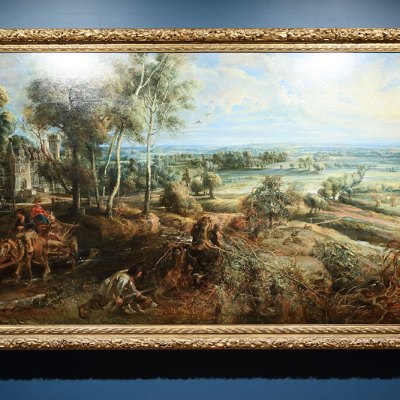Royal Museum of Fine Arts Antwerp
Reopened September 2022
Even for a city as rich in museums as Antwerp, something has been missing for the past 11 years. In September 2022, however, after an arduous €100m programme of restoration and remodelling, the Royal Museum of Fine Arts Antwerp (KMSKA) finally reopened. The largest collection of art in Flanders now has a home capacious enough to display the pick of its holdings, from Jan van Eyck’s Saint Barbara of Nicomedia of 1437 to René Magritte’s The Sixteenth of September of 1956.
The original museum opened in 1890 and, porticoed, columned and statue-topped, was standard issue for a late 19th-century art gallery. Nevertheless, it quickly became too small for its collection. Now KAAN Architecten has proved that it is not just nature that abhors a vacuum by inserting a new gallery block into the voids of four inner courtyards. These display rooms and the series of dramatic statement staircases that link them to the old building are determinedly modern – bright white, crisp-edged and lit by nearly 200 skylights, they give the museum 40 per cent more space.
Although the KMSKA is best known for its Flemish Primitives – Van Eyck, Memling, Rogier van der Weyden et al. – and later, local Old Masters such as Rubens and Van Dyck, the older paintings amount to just 22 per cent of the 8,400 works in the collection; the bulk are from the 19th and 20th centuries. The museum has turned this fact into a visitor choice. The historic galleries, with their coloured walls and parquet floors, remain stately and show works from before 1880, while the 10 new rooms house the more modern pictures. The art of James Ensor, of which the KMSKA has the world’s largest collection, acts as a bridge between the two with a gallery of its own. In all, some 650 works are now on display.
The revamp has been thorough, with worn-out 19th-century mosaics replaced, facades cleaned to reveal original colours, the conservation studio returned to the museum and cafe and public spaces all titivated to a greater or lesser degree. The KMSKA has also acquired a new motto, ‘The Finest Feeling’, meant to apply not just to the act of looking at art but to every aspect of visiting the museum. Feelings are both fugitive and subjective, but in offering both the traditional and the avant-garde in the same building, the museum has ensured that many of the sensations aroused will indeed be fine.
The Royal Museum of Fine Arts Antwerp. Photo: © Mediamixer

Michael Prodger is a senior research fellow at the University of Buckingham and art critic for the New Statesman.



